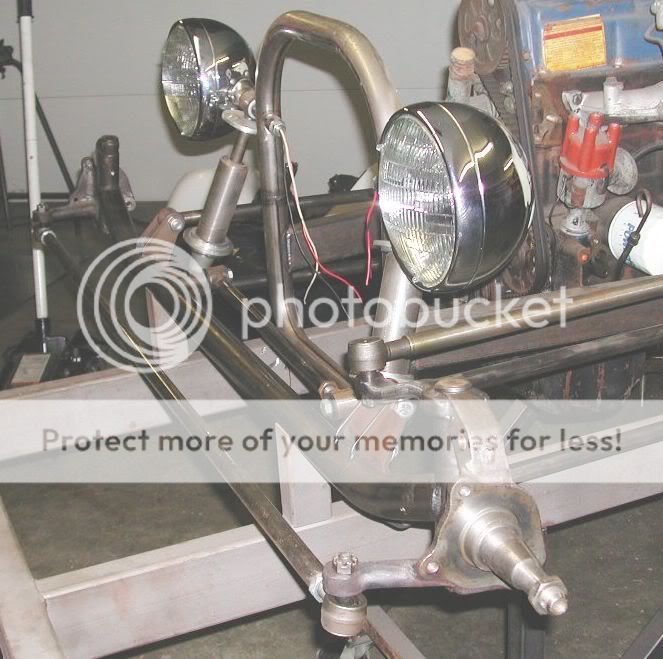ACKERMAN STEERING
Maybe this will help some of you guys to understand the Ackerman principle and how it affects T-Buckets. The basic theory is that the front wheels of a 2 wheel steer vehicle with the steering on the front should remain tangent to the turning circles of each individual wheel. It is theorized that the center point of these circles falls on a line that is the same as the centerline of the rear axle housing projected out into space. The center of the both arcs is at the same point on the rear axle centerline. That centerpoint slides along that line as the amount of steering input is changed. In other words, on a small amount of turn the centerpoint is way out there, in a hard turn the center is closer to the car. In the straight-ahead position the centerpoint is at infinity. That's way, way, way out there! It's time for a little drawing to keep from confusing you with this attempt at an explanation.


Time for another illustration. O.K., automobiles steered fine and everyone was happy. And along comes Joe Hot Rod and he decides that his heap needs to be nice and low. Hey, no problem. Let's move the spring back behind the axle and down nice and low. Looks great, in da weeds! Oops, small problem, no place for the tie rod to run back there. Imagine that you can see a "great idea" light bulb over Joe's head. Hey that's easy, just swap the spindles side for side and put the tie rod on the front. Look, the wheels still are connected and turn when you give the steering wheel a twist. That will cure all of my problems.

Well not quite Joe. You have just wiped out Mr. Ackerman's principle. Your tie rod attachment points (tie rod end or heim joint) no longer fall on that imaginary line. So what happens now? Well, either the inside wheel does what it is supposed to do, or the outside wheel behaves correctly, but not both at the same time. So now old Joe has that nice set of new high dollar tires grinding themselves up on the local asphalt every time he goes around a corner. The car also has a tendency to get a little quirky because the wheels can't make up their minds which one is going to be in charge of where they are going to point.

Is old Joe just screwed on this deal now, stuck with this problem? Nope! He just needs to get those pesky attachment points back over on Mr. Ackerman's imaginary line. It works just as well on a front mounted tie rod as a rear mounted one. Remember, Mr. Ackerman found out that it was universal. It depends on what he has for front-end hardware as to what he can do to correct this situation. Early Ford spindles with the built on steering arms can be heated and bent to get back out there where they should be. Just be darn careful doing it; if you don't know what you're doing find someone who does and have them do it. The aftermarket offers some parts that can take care of this problem. Sometimes special design parts will need to be made. A lot depends on the individual situation. Brake configurations (calipers and rotors mostly) can create some interesting obstacles. If you can't get out there where Mr. Ackerman says you should be, at least get as close as you can.

Lo and behold, old Joe made the changes and guess what? His lo and in da weeds bucket is cruising along life's highway is fine style. Tire life is improved, steering is less quirky (still needs a little work on the bumpsteer deal) and he is all smiles.

Well, old Joe is not alone on this deal, he's got lots of buddies with the same problem and they haven't done a thing about it. So what happens? Well they just go cruising alongof course they stop by the tire store a little more often than Joe and leave some of their hard earned. And they have to pay a little closer attention to where their missile is headed when all of the guys are out for a cruise and find that great little road with all of the curves that just beg for a guy to open it up just a tad.a tad? Yah right!
By George Barnes





